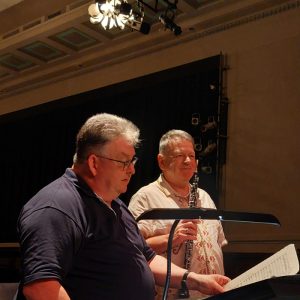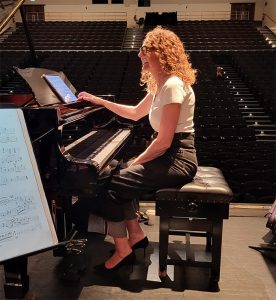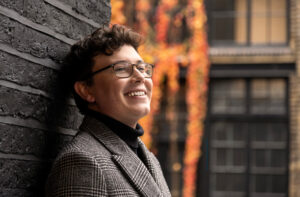The Royal Tunbridge Wells Symphony Orchestra’s last concert of the 2022/23 season was on 2 April, and what a finale it proved to be. The season ended with the RTWSO’s Music Director Roderick Dunk conducting, and Callum Smart was the soloist in Mendelssohn’s Violin Concerto. In the absence of regular leader Julian Leaper, the orchestra was ably led by international violinist David Juritz who struck up an immediate rapport with the musicians.
There were so many unfamiliar instruments on stage that any music teacher might have posed the question to their pupils, “Name that instrument?” Certainly seeing, and hearing, these non-standard orchestral instruments conjured up an interesting afternoon, delighting the senses along the way – as in the earthy sound produced by the contrabassoon and the surprising inclusion of the alto saxophone. The concert featured Ravel’s Mother Goose Suite, Mendelssohn’s Violin Concerto and Rachmaninoff’s Symphonic Dances. It was in the Ravel and Rachmaninoff pieces that the following instruments appeared: alto saxophone, bass clarinet, contrabassoon, tuba, harp, celeste, cymbals, glockenspiel, tambourine, tam-tam, triangle, tubular bells, xylophone and piano.
Ravel’s quirky score for his Mother Goose Suite embraces not only some of the said non-standard orchestral instruments but also calls for some of the usual instruments to be played in a quirky way, for example in the second movement Tom Thumb, there are solo violin entries imitating bird song, to which ‘twittering’ solo flutes respond. The third movement Laideronette, Empress of the Pagodas was full of Eastern Promise; the effect created by Ravel’s use of the pentatonic scale. In the fourth movement Beauty and the Beast Ravel gave the strings a back seat for much of the time and attention focussed on the woodwind, harp and percussion instruments with exposed clarinet solos representing Beauty and the ‘ugly’ growling of the contrabassoon summoning up the Beast. If the third movement was based on the pentatonic scale then the last The Fairy Garden was full of harmony and harmonics. Ravel, a master of orchestration, was quite specific in wanting a particular sound and on one occasion the score indicates that the cymbals should be played ‘avec baguettes’ – no, not a bread stick but a wooden one! Ravel was at his most enigmatic in this piece.
The soloist in the Mendelssohn Violin Concerto was Callum Smart making a very welcome return to playing with the orchestra. Callum shot to fame when at the age of 13 he won the Strings category in the BBC Young Musician Competition in 2010. He has played with the RTWSO in 2013 (Britten’s Violin Concerto) and in 2016 (Korngold’s Violin Concerto). One problem with playing a very well-known concerto is that expectations can be dashed as comparisons with a favourite recording or performer can interfere with appreciating any other performance. So what did Callum Smart bring to this performance to make it stand out? Well, for a start he took control of the stage (no sheet music in sight!) and had an excellent connection with the conductor and orchestra. However, whilst everyone knew that Callum’s pedigree at such a young age would ensure a memorable performance, not every soloist can achieve that balance of serving the composer’s intentions and melding as part of a team with the orchestra. A concerto is, after all, a team effort. At the end of the concerto the hitherto mesmerised audience erupted into passionate acclamation with several minutes of applause and ‘stamping’! Callum will certainly be welcomed back again.
The last item to close the concert, and the 2022/23 season, was Rachmaninoff’s Symphonic Dances. Sponsored by former RTWSO Chairman, Giles Clarke and his wife Helen, this work shows Rachmaninoff at his most rhythmic – there are hints of the same rhythmic intensity found in the Dance of the Knights from Prokofiev’s ballet Romeo and Juliet. It is also probably one of the most challenging pieces to play and bring off as there are pitfalls to negotiate. For example, apart from the actual notes and the playing of them, there are many bars of rests where no sound should be heard. Any premature entry by a player can ruin the whole effect – of course, this did not happen! The two majestic and rhythmic outer movements are sandwiched by a quieter, introspective waltz. Overall, many of the quieter moments in the piece, often with lush scoring, could easily be transferred to the silver screen.
This last concert signed off a very successful season for the orchestra. Audience attendance levels have steadily risen post-pandemic and the standard of orchestral playing would be hard to beat, certainly in the south-east of England. One mustn’t forget that this is a pro-am orchestra where gifted local players benefit immensely from playing alongside their professional colleagues – all under the excellent direction of Roderick Dunk and a strong, effective Management team. Alongside this, the RTWSO’s Education Outreach Project team works tirelessly in local schools seeking to reach out to a younger audience to inspire them and nurture their talent.




